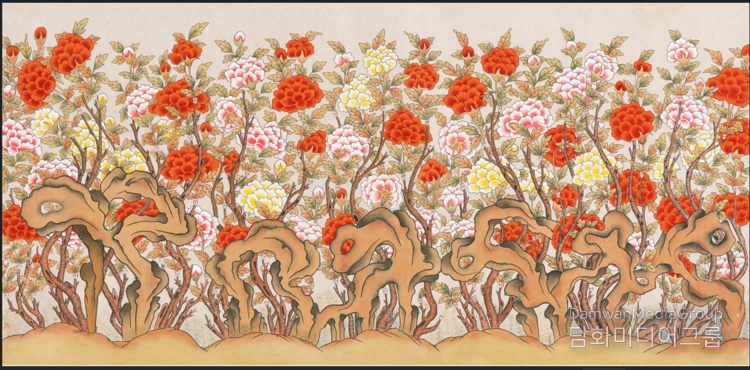By Diplomacy Journal Kayla Lee
Among traditional Korean paintings, Goeseokmorando, or 怪石牡丹圖 has attracted the attention of many for its unique beauty and deep philosophical meaning.
The painting depicts a strange rock found in nature, Goeseok, and a peony, which symbolizes wealth and honor, and it ehas become one of the most representative genres of the Joseon Dynasty.

The history of Goseokmorando begins with the genre's development in the late Joseon Dynasty, especially from the 17th to the 19th centuries. This was a time when traditional landscape painting and flower-and-bird painting were fused, and Confucian ideas of idealizing nature were combined with aesthetic sensibilities. Against this cultural background, Goeseokmorando emerged as an independent genre.
Joseon-era art often emphasized the harmony between nature and humans, and Goeseokmorando sought to visually express this harmony through its symbolic elements. The painting's combination of rugged rocks and colorful peony blossoms served to symbolize the virtues and ideal life found in nature to the late Joseon people.
The subjects of Goeseokmorando, 'goeseok' and 'peony', each have their own symbolism. Goeseok is an atypical, oddly shaped rock that represents constancy, patience, and strength. It is connected to Confucian virtues and symbolizes the spirit of a noble man who remains unchanged even in the harsh environment of nature.
Peony is a flower that symbolizes wealth and beauty, and during the Joseon Dynasty, it was especially considered a symbol of aristocratic and opulent life. Its abundant petals and gorgeous colors were loved by the people of the time as a symbol of wealth and honor.
Through the harmonization of these two elements, Goeseokmorando sought to express the ideal of nature and human life. The stones in the painting represent the wonders of nature and the virtues that humans should emulate, while the peony represents the richness and beauty of life.
Style and technique aesthetics of delicacy and detail, Goeseokmorando was primarily painted using the paintings meticulous technique. It is characterized by extremely delicate handwriting and precise detail, which makes the rough texture of the rocks and the brilliant colors of the peonies stand out even more. The use of ink and the strength of the lines are important elements, with the use of playfulness to depict the hard surface of the rocks, while the peonies are rendered in a variety of colors to add to their vibrancy.
Representative artists and works include Jeong Sun, Shim Sa-jung, and Kim Hong-do, who represented the late Joseon Dynasty. These artists sought to express the idealized relationship between nature and humans through Goeseokmorando, and Jeongseon's works, in particular, exemplify Korean natural beauty and philosophical depth. Jeong is also known as a master of Korean mountain painting, and his Goeseokmorando is considered a representative work that shows the essence of the late Joseon painting style.
In terms of modern meaning and value, Goeseokmorando is more than just decorative paintings; it is an important artistic genre that provides a glimpse into the philosophical depth and aesthetic sense of traditional Korean painting. Even today, these works continue to inspire many artists and scholars and are recognized as part of Korea's cultural heritage. Inheriting the tradition and reinterpreting it in a modern way, Goeseokmorando is a reminder of the beauty of Korean painting.
Goeseokmorando holds an important place in Korean art history, enriching our visual and emotional senses with its natural, human, and philosophical meanings. It honors the artistic achievements of the Joseon Dynasty, and its depth and beauty continues to move many people today.
